Haryana State Board HBSE 10th Class Maths Solutions Chapter 3 Pair of Linear Equations in Two Variables Ex 3.5 Textbook Exercise Questions and Answers.
Haryana Board 10th Class Maths Solutions Chapter 3 Pair of Linear Equations in Two Variables Ex 3.5
Question 1.
Which of the following pairs of linear equations has unique solution, no solution, or infinitely many solutions. In case there is a unique solution, find it by using cross multiplication method
(i) x – 3y – 3 = 0
3x – 9y – 2 = 0
(ii) 2x + y = 5
3x + 2y = 8
(iii) 3x – 5y = 20
6x – 10y = 40
(iv) x – 3y – 7 = 0
3x – 3y – 15 = 0.
Solution :
(i) The given equations are;
x – 3y – 3 = 0
3x – 9y – 2 =0
Comparing the given equations with the stan-dard form of linear equations a1x + b1y + c1 = 0 and a2x + b2y + c2 = 0, we get
a1 = 1, b1 = – 3, c1 = – 3, a2 = 3, b2 = – 9, c2 = – 2
\(\frac{a_1}{a_2}=\frac{1}{3}\)
\(\frac{b_1}{b_2}=\frac{-3}{-9}=\frac{1}{3}\)
and \(\frac{c_1}{c_2}=\frac{-3}{-2}=\frac{3}{2}\)
Since \(\frac{a_1}{a_2}=\frac{b_1}{b_2} \neq \frac{c_1}{c_2}\).
So, pair of linear equations has no solution.
![]()
(ii) We can write the given equations in general form :
2x + y – 5 = 0
3x + 2y – 8 = 0
Comparing the given equations with the standard form of linear equations a1x + b1y + c1 = 0 and a2x + b2y + c2 = 0, we get
a1 = 2, b1 = 1, c1 = – 5, a2 = 3, b2 = 2, c2 = – 8
\(\frac{a_1}{a_2}=\frac{2}{3}\)
\(\frac{b_1}{b_2}=\frac{1}{2}\)
and \(\frac{c_1}{c_2}=\frac{-5}{-8}=\frac{5}{8}\)
Since \(\frac{a_1}{a_2} \neq \frac{b_1}{b_2}\)
So, the pair of linear equations has a unique solution.
By Cross Multiplication Method:
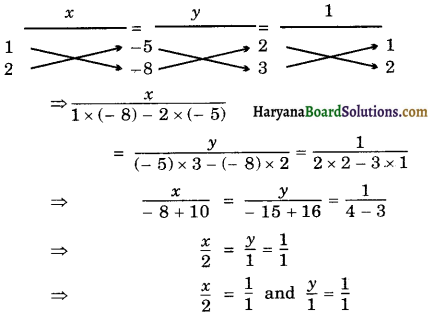
x = 2 and y = 1.
Hence, x = 2, y = 1 is the required solution.
![]()
(iii) We can write the given equations in general form :
3x – 5y – 20 = 0
6x – 10y – 40 = 0
Comparing the given equations with the standard form of linear equations a1x + b1y + c1 = 0 and a2x + b2y + c2 = 0, we get
a1 = 3, b1 = – 5, c1 = – 20, a2 = 6, b2 = 10,
c2 = – 40
\(\frac{a_1}{a_2}=\frac{3}{6}=\frac{1}{2}\)
\(\frac{b_1}{b_2}=\frac{-5}{-10}=\frac{1}{2}\)
and \(\frac{c_1}{c_2}=\frac{-20}{-40}=\frac{1}{2}\)
Since \(\frac{a_1}{a_2}=\frac{b_1}{b_2}=\frac{c_1}{c_2}\)
So, the pair of linear equations has infinitely many solutions.
(iv) The given equations are:
x – 3y – 7 = 0
3x – 3y – 15 = 0
Comparing the given equations with the standard form of linear equations a1x + b1y + c1 = 0 and a2x + b2y + c2 = 0, we get
a1 = 1, b1 = – 3, c1 = – 7, a2 = – 3, b2 = – 3,
c2 = – 15
\(\frac{a_1}{a_2}=\frac{1}{3}\)
\(\frac{b_1}{b_2}=\frac{-3}{-3}\) = 1
and \(\frac{c_1}{c_2}=\frac{-7}{-15}=\frac{7}{15}\)
Since, \(\frac{a_1}{a_2} \neq \frac{b_1}{b_2}\)
So, the pair of linear equations has a unique solution.
By Cross Multiplication Method:

x = 4, and y = – 1
Hence, x = 4, y = – 1 is the required solution.
![]()
Question 2.
(i) For which values of a and b does the following pair of linear equations have an infinite number of solutions ?
2x + 3y = 7
(a – b) x + (a + b) y =3a + b – 2
(ii) For which value of k will the following pair of linear equations have no solution ?
3x + y = 1
(2k – 1) x + (k – 1) y = 2k + 1
Solution:
(i) We can write the given equations in general form :
2x + 3y – 7 = 0
(a – b) x + (a + b) y – 3a – b + 2 = 0
Comparing the given equations with the standard form of linear equations a1x + b1y + c1 = 0 and a2x + b2y + c2 = 0, we get
a1 = 2, b1 = 3, c1 = – 7, a2 = a – b, b2 = a + b,
c2 = – 3a – b + 2
Condition for infinite number of solutions is:
\(\frac{a_1}{a_2}=\frac{b_1}{b_2}=\frac{c_1}{c_2}\)
\(\frac{2}{a-b}=\frac{3}{a+b}=\frac{-7}{-3 a-b+2}\)
\(\frac{2}{a-b}=\frac{3}{a+b}=\frac{7}{3 a+b-2}\)
\(\frac{2}{a-b}=\frac{3}{a+b}\) and
\(\frac{3}{a+b}=\frac{7}{3 a+b-2}\)
⇒ 2a + 2b = 3a – 3b
and 3(3a + b – 2) = 7 (a + b)
⇒ 2a – 3a + 2b + 3b = 0
and 9a + 3b – 6 = 7a + 7b
⇒ – a + 5b = 0
and 9a – 7a + 3b – 7b – 6 = 0
⇒ – a + 5b = 0
and 2a – 4b – 6 = 0
We will solve these equations by elimination method. The equations are :
– a + 56 = 0 ……………..(1)
2a – 46 = 6 ………………(2)
Multiplying equation (1) by 2 and adding it to equation (2), we get
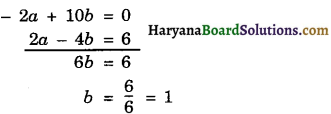
Substituting the value of 6 in equation (1), we get
– a + 5 × 1 = 0
⇒ – a = – 5
⇒ a = 5
Hence, a = 5, b = 1.
![]()
(ii) We can write the given equations in gen¬eral form :
3x + y – 1 = 0
(2k – 1) x + (k – 1) y – 2k – 1 = 0
Comparing the given equations with the stan-dard form of linear equations a1x + b1y + c1 = 0 and a2x + b2y + c2 = 0, we get
a1 = 3, b1 = 1, c1 = – 1, a2 = 2k – 1, b2 = k – 1, c2 = – (2k + 1)
The condition for no solution is :
\(\frac{a_1}{a_2}=\frac{b_1}{b_2} \neq \frac{c_1}{c_2}\)
\(\frac{3}{2 k-1}=\frac{1}{k-1} \neq \frac{-1}{-(2 k+1)}\)
\(\frac{3}{2 k-1}=\frac{1}{k-1}\)
and \(\frac{1}{k-1} \neq \frac{1}{2 k+1}\)
3k – 3 = 2k – 1
k – 1 ≠ 2k + 1
3k – 2k = – 1 + 3
3k – 2k = – 1 + 3
and k – 2k ≠ 1 + 1
k = 2 and – k ≠ 2
k = 2 and k ≠ – 2
Hence, k = 2.
![]()
Question 3.
Solve the following pair of linear equations by substitution method and cross multiplication method :
8x + 5y = 9
3x + 2y = 4
Solution :
By Substitution Method :
The given equations are ;
8a + 5y = 9 ………………(1)
3x + 2y = 4 ………………(2)
From equation (2), we get
3a = 4 – 2y
x = \(\left(\frac{4-2 y}{3}\right)\)
Substituting the value of x in equation (1), we get
8(\(\left(\frac{4-2 y}{3}\right)\)) + 5y = 9
⇒ \(\frac{32-16 y}{3}\) + 5y = 9
⇒ \(\frac{32-16 y+15 y}{3}\) = 9
⇒ \(\frac{-y+32}{3}\) = 9
⇒ – y + 32 = 27
⇒ – y = 27 – 32 = – 5
⇒ y = 5
Putting the v1ue ofy in equation (1), we get
8x + 5 × 5 = 9
⇒ 8x + 25 = 9
⇒ 8x = 9 – 25 = – 16
⇒ x = \(-\frac{16}{8}\) = – 2
Hence, x = – 2; y = 5 is the required solution.
By Cross Multiplication Method:
The given equations are
8x + 5y = 9
3x + 2y = 4
By cross multiplication, we get
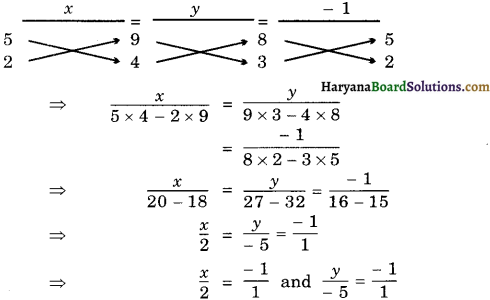
Hence, x = – 2; y = 5 is the required solution.
![]()
Question 4.
Form the pair of linear equations in the following problems and find their solutions (If they exist) by any algebraic method :
(i) A part of monthly hostel charges is fixed and the remaining depends on the number of days one has taken food in the mess. When a student A takes food for 20 days she has to pay ₹ 1000 as hostel charges whereas a student B, who takes food for 26 days, pays ₹ 1180 as hostel charges. Find the fixed charges and the cost of food per day.
(ii) A fraction becomes when \(\frac{1}{2}\) is subtracted from the numerator and it becomes \(\frac{1}{4}\) when 8 is added to its denominator. Find the fraction.
(iii) Yash scored 40 marks in a test, getting 3 marks for each right answer and losing 1 mark for each wrong answer. Had 4 marks been awarded foi each correct answer and 2 marks been deducted for each incorrect answer, then Yash would have scored 50 marks. How many questions were there in the test?
(iv) Places A and B are 100 km apart on a highway. One car starts from A and another from B at the same time. If the cars travel in the same direction at different speeds, they meet in 5 hours. If they travel towards each other, they meet in 1 hour. What are speeds of the two cars?
(v) The area of rectangle gets reduced by 9 square units, if its length is reduced by 5 units and breadth is increased by 3 units. If we increase the length by 3 units and the breadth by 2 units, the area increases by 67 square units. Find the dimensions of the rectangle.
![]()
Solution:
(i) Let the fixed charge of hostel be ₹ x and cost of food per day be ₹ y.
According to question,
x + 20y = 1000
and x + 26y = 1180
By Cross Multiplication Method, we get
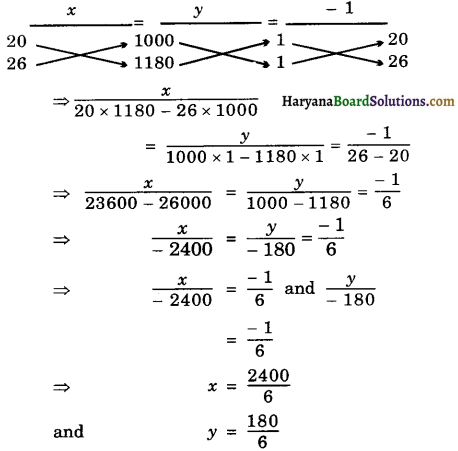
x = 400 and y = 30
Hence, equations are x + 20y = 1000, x + 26y = 1180 and x = 400, y = 30 is the required solution.
Therefore, Fixed charge of hostel = 400
and cost of food per day = 30
(ii) Let the numerator be x and denomin cor be y,
then fraction = \(\frac{x}{y}\)
According to question,
\(\frac{x-1}{y}=\frac{1}{3}\)
3x – 3 = y
3x – y – 3 = 0 ……………….(1)
and \(\frac{x}{y+8}=\frac{1}{4}\)
4x = y + 8
4x – y – 8 = 0 ………………(2)
By Cross Multiplication Method, we get
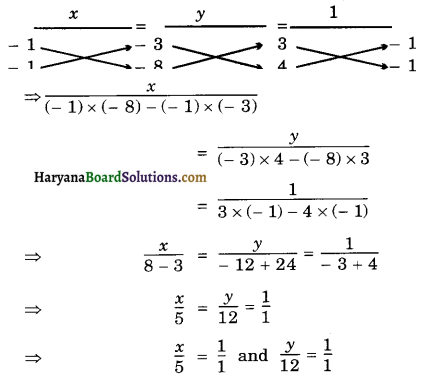
x = 5 and y = 12
Hence, the equations are 3x – y – 3 = 0, 4x – y – 8 = 0 and x = 5, y = 12 is the required solution.
Therefore, the fraction = \(\frac{5}{12}\).
![]()
(iii) Let the number of right answer be = x and
number of wrong answers be = y
Then total questions = x + y
According to question
3x – y = 40 ………………..(1)
and 4x – 2y = 50 ……………..(2)
By Cross Multiplication Method, we get
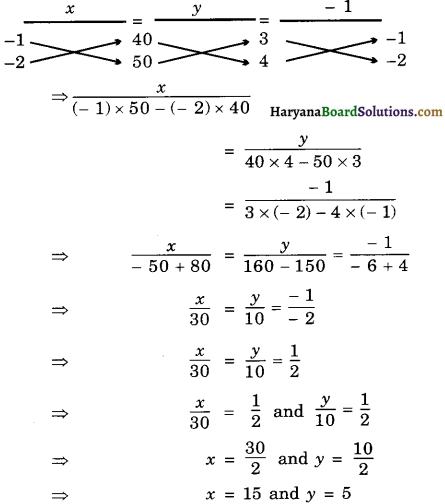
Hence, the equations are; 3x – y = 40, 4x – 2y = 50 and x = 15, y = 5 is the required solution.
Therefore, total questions = 15 + 5 = 20.
![]()
(iv) Let the speed of first car be x km/hr and speed of second car be y km/hr.
Case I :
When they travel in same direction, they meet at point C.

Distance covered by first car in 5 hours = 5 x km.
[∵ Distance = Speed × Time]
Distance covered by second car in 5 hours = 5y km.
Since AC – BC = AB
Therefore, 5x – 5y = 100
⇒ x – y = 20 ……………(1)
Case II:
When they travel in opposite direc-tions. They meet at point C.

Distance covered by first car in 1 hour = x km.
Distance covered by second car in 1 hour = y km.
Since AC + BC = AB
Therefore, x + y = 100 ……………..(2)
So, the equations are
x – y = 20
x + y = 100
By Cross Multiplication Method, we get
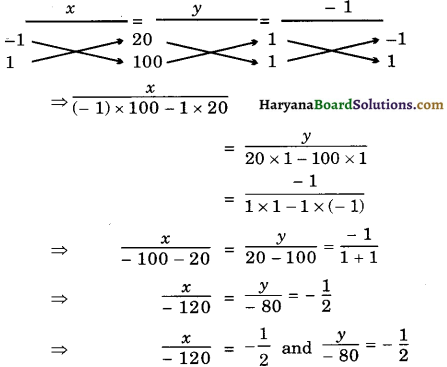
x = \(\frac{120}{2}\) and y = \(\frac{80}{2}\)
⇒ x = 60 and y = 40
Hence, the equations are; x – y = 20, x + y = 100.
And x = 60, y = 40 is the required solution.
Therefore, speed of first car = 60 km/hr
and speed of second car = 40 km/hr.
![]()
(v) Let the length of rectangle be x units and breadth of rectangle be y units
∴ Area of rectangle = xy square units
According to question,
xy – (x – 5)(y + 3) = 9
⇒ xy – [xy + 3x – 5y – 15] =9
⇒ xy – xy – 3 + 5y + 15 = 9
⇒ – 3x + 5y + 15 – 9= 0
⇒ – 3x + 5y + 6 = 0
⇒ 3x – 5y – 6 = 0 ………….(1)
and (x + 3)(y + 2) = xy + 67
⇒ 3 – xy + 2x + 3y + 6 = xy + 67
⇒ xy + 2x + 3y – xy + 6 – 67 = 0
⇒ 2x + 3y – 61 = 0 …………….(2)
So, the equations are :
3x – 5y – 6 = 0
2x + 3y – 61 = 0
By Cross Multiplication Method, we get
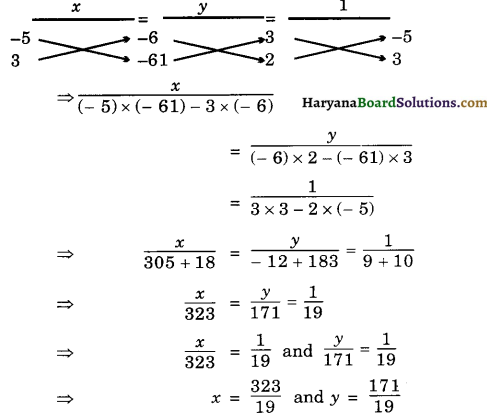
x = 17 and y = 9
Hence, equations are 3x – 5y – 6 = 0, 2x + 3y – 61 = 0.
And x = 17 and y = 9 is the required solution.
Therefore, length = 17 units, breadth = 9 units.